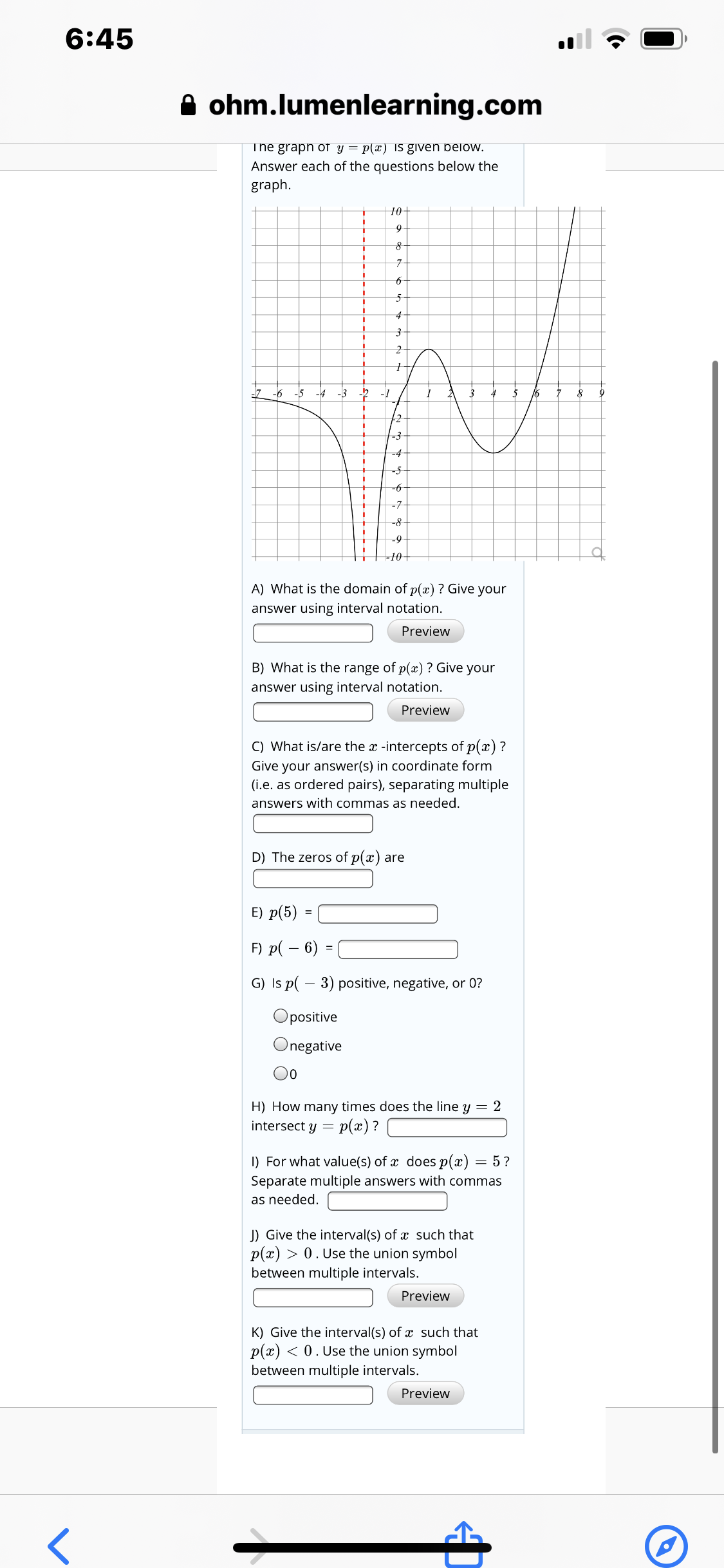6:45 A ohm.lumenlearning.com The graph of y = p(x) IS given below. Answer each of the questions below the graph. 10 5- -5 -4 -3 -1 16 +2 -3 -4 -6 -7- -8 -9 -10+ A) What is the domain of p(x) ? Give your answer using interval notation. Preview B) What is the range of p(æ) ? Give your answer using interval notation. Preview C) What is/are the x -intercepts of p(x) ? Give your answer(s) in coordinate form (i.e. as ordered pairs), separating multiple answers with commas as needed. D) The zeros of p(x) are E) p(5) = F) p( – 6) = G) Is p( – 3) positive, negative, or 0? Opositive Onegative 00 H) How many times does the line y = 2 p(x) ? intersect y = I) For what value(s) of x does p(x) = 5? Separate multiple answers with commas as needed. J) Give the interval(s) of x such that p(x) > 0. Use the union symbol between multiple intervals. Preview K) Give the interval(s) of x such that p(x) < 0. Use the union symbol between multiple intervals. Preview
6:45 A ohm.lumenlearning.com The graph of y = p(x) IS given below. Answer each of the questions below the graph. 10 5- -5 -4 -3 -1 16 +2 -3 -4 -6 -7- -8 -9 -10+ A) What is the domain of p(x) ? Give your answer using interval notation. Preview B) What is the range of p(æ) ? Give your answer using interval notation. Preview C) What is/are the x -intercepts of p(x) ? Give your answer(s) in coordinate form (i.e. as ordered pairs), separating multiple answers with commas as needed. D) The zeros of p(x) are E) p(5) = F) p( – 6) = G) Is p( – 3) positive, negative, or 0? Opositive Onegative 00 H) How many times does the line y = 2 p(x) ? intersect y = I) For what value(s) of x does p(x) = 5? Separate multiple answers with commas as needed. J) Give the interval(s) of x such that p(x) > 0. Use the union symbol between multiple intervals. Preview K) Give the interval(s) of x such that p(x) < 0. Use the union symbol between multiple intervals. Preview
Algebra & Trigonometry with Analytic Geometry
13th Edition
ISBN:9781133382119
Author:Swokowski
Publisher:Swokowski
Chapter5: Inverse, Exponential, And Logarithmic Functions
Section5.1: Inverse Functions
Problem 56E
Related questions
Question
Hey can I get the bottom part answers D-k

Transcribed Image Text:6:45
A ohm.lumenlearning.com
The graph of y = p(x) IS given below.
Answer each of the questions below the
graph.
10
5-
-5 -4 -3
-1
16
+2
-3
-4
-6
-7-
-8
-9
-10+
A) What is the domain of p(x) ? Give your
answer using interval notation.
Preview
B) What is the range of p(æ) ? Give your
answer using interval notation.
Preview
C) What is/are the x -intercepts of p(x) ?
Give your answer(s) in coordinate form
(i.e. as ordered pairs), separating multiple
answers with commas as needed.
D) The zeros of p(x) are
E) p(5) =
F) p( – 6) =
G) Is p( – 3) positive, negative, or 0?
Opositive
Onegative
00
H) How many times does the line y = 2
p(x) ?
intersect y =
I) For what value(s) of x does p(x) = 5?
Separate multiple answers with commas
as needed.
J) Give the interval(s) of x such that
p(x) > 0. Use the union symbol
between multiple intervals.
Preview
K) Give the interval(s) of x such that
p(x) < 0. Use the union symbol
between multiple intervals.
Preview
Expert Solution
This question has been solved!
Explore an expertly crafted, step-by-step solution for a thorough understanding of key concepts.
This is a popular solution!
Trending now
This is a popular solution!
Step by step
Solved in 3 steps with 3 images

Knowledge Booster
Learn more about
Need a deep-dive on the concept behind this application? Look no further. Learn more about this topic, algebra and related others by exploring similar questions and additional content below.Recommended textbooks for you

Algebra & Trigonometry with Analytic Geometry
Algebra
ISBN:
9781133382119
Author:
Swokowski
Publisher:
Cengage

Algebra: Structure And Method, Book 1
Algebra
ISBN:
9780395977224
Author:
Richard G. Brown, Mary P. Dolciani, Robert H. Sorgenfrey, William L. Cole
Publisher:
McDougal Littell

Algebra & Trigonometry with Analytic Geometry
Algebra
ISBN:
9781133382119
Author:
Swokowski
Publisher:
Cengage

Algebra: Structure And Method, Book 1
Algebra
ISBN:
9780395977224
Author:
Richard G. Brown, Mary P. Dolciani, Robert H. Sorgenfrey, William L. Cole
Publisher:
McDougal Littell